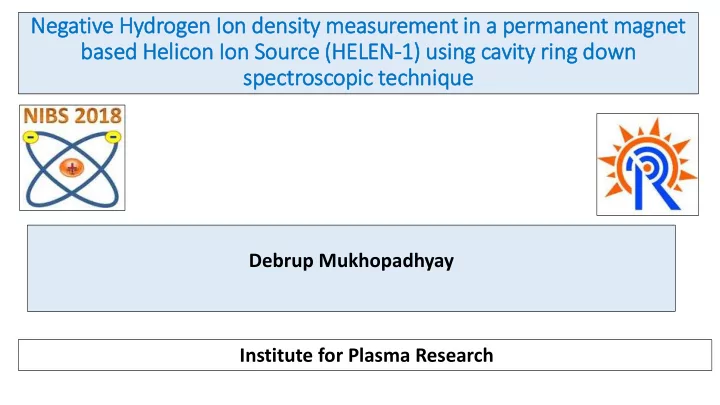

Negativ ive Hydrogen Io Ion densit ity measurement in in a permanent magnet based Helic licon Io Ion Source (HELEN-1) usin ing cavit ity rin ing down spectroscopic ic techniq ique Debrup Mukhopadhyay Institute for Plasma Research
Presentation overview : • Motivation • A brief discussion of the in house developed Cavity Ring down Spectrometer in the Institute for Plasma Research • Description of the experimental setup • Characterization of the negative ion density profile for HELEN-1 with Cavity ring down Spectrometer is presented • Future Plans 07-09-2018 2
Motivation • Negative ion based ion source are important for NNBI system (beam energy >100 keV) • Measurement of negative ion density is important for characterization and optimization of any ion source • Cavity ring down diagnostic is a sensitive technique in which the line integrated negative ion density can be measured non invasively • In our experiments, A cavity ring down spectrometer is successfully established and is used to measure Negative ion density in a Helicon device .
Cavity Rin ing down Spectroscopy BASIC PRINCIPLE OF RING DOWN SPECTROSCOPY • mean photon life time is increased by multiple reflection 𝑴 𝝊 𝑩𝑪𝑻 = , 𝜷 = 𝑫𝒑𝒇𝒈𝒈𝒋𝒅𝒋𝒇𝒐𝒖 𝒑𝒈 𝑩𝒄𝒕𝒑𝒔𝒒𝒖𝒋𝒑𝒐 = 𝒅𝒔𝒑𝒕𝒕 𝒕𝒇𝒅𝒖𝒋𝒑𝒐 × 𝑶𝒗𝒏𝒄𝒇𝒔 𝒆𝒇𝒐𝒕𝒋𝒖𝒛 𝒅 𝟐−𝑺 +𝜷𝒆 07-09-2018 4
CR CRDS desig ign consid ideratio ion System parameters values Coefficient of reflection of dielectric .9999 mirrors Separation between Cavity Mirrors(L) 1.2 m Radius of curvature of the mirrors 6m 𝑴 Stability Criteria and g value 𝟏 < 𝒉 𝟐 𝒉 𝟑 < 𝟐 ; 𝒉 = 𝟐 − 𝒔 𝒉 𝟐 𝒉 𝟑 =.64 INNOLAS SpitLight Compact 200 (Nd:YAG) 1064nm, Pulse width 5 nm, maxEnergy per pulse 150 mille joule Photo detector p-i-n photo-detector (InGaAs) ,detection range 400nm -1700nm ,Gain 70 dB Oscilloscope (Tektronix MSO3014) Bandwidth 100MHz,Sampling rate 2GHz per sec 07-09-2018 5
Measurement Techniq ique u used to extr xtract rin ring down tim time RAW SIGNAL BASE OFF SET ELIMINATION LOG SCALE EXPONENTIAL FIT RING DOWN TIME ESTIMATION RING DOWN TIME FOR VACUUM AND FITTING PARAMETERS 07-09-2018 6
HELEN -1 07-09-2018 7
Experimental set up details Vacuum vessel Source and expansion chamber Axial magnetic field NdFeB permanent ring magnet RF generator and auto tuning impedance circuit M/s T&C Power Conversion, Inc. Make Operating frequency 13.56MHz Antenna Nagoya III antenna, of 36 mm length CRDS installation CRDS is integrated with HELEN by a vacuum compatible transition flange Parameters taken into consideration under experiment : • Alignment • Deformation of the vessel due to differential pressure gradient • Mirror reflectivity is measured with CRDS setup before experiment • Reflected RF power is less than 1 % for every shots 07-09-2018 8
Pla lasma parameters of HELEN Plasma density and Temperature profile for different RF power and magnetic field in driver 07-09-2018 9
PLASMA PARAMETERS FOR HELEN -1 Radial profile of plasma density and temperature at the Probing location of CRDS 07-09-2018 10
Layout of the CR CRDS system with ith Hele len-1 07-09-2018 11
Characteriz izatio ion of negativ ive io ion in in Hele len-1 • RDT is taken in vacuum • RDT is taken in working pressure of 10 -2 mbar • RDT is taken for different power at 55 Gauss axial magnetic field • The density variation after 600 watt cannot be detected due to sensitivity limit of the present setup Power characterization of negative ion for HELEN 07-09-2018 12
Negative io ion density Negative ion density plot for different power
Characterization continued The negative ion density plot for different axial magnetic field for different RF powers at constant working pressure of 8x10 -3 mbar 07-09-2018 14
Characterization continued Negative ion density plot for different working pressure and magnetic field at constant power
Particle balance source loss EV reaction Disassociation of excited molecules Relaxation by wall collision Dissociative attachment Ionization of excited molecules 07-09-2018 16
Part rtic icle le bala lance conti tinued . SOURCE LOSS Dissociative attachment Mutual neutralization Loss by collision with wall 07-09-2018 17
summary • High negative ion density is can be obtained in the Helicon setup even without cesium injection • No dependence on axial field is obtained in the axial magentic field under consideration • Sensitivity of CRDS need to be increased in order to detect the negative ion density in lower power regime • The variation in negative ion density is negligible in higher power regime and is in the same order • The negative ion density variation with working pressure under consideration is not that much 07-09-2018 18
Futu ture work rk • Automation will be installed for monitering any misalignment during the experimental conditions . • Much more precise particle balance and monte carlo model will be developed for validation of experimental data • Other negative ion measurement diagnostics like Laser aided photo detechment method is under development. • CRDS will be intregtared in TWIN source ,ROBIN and INTF 07-09-2018 19
THANK YOU 07-09-2018 20
Recommend
More recommend